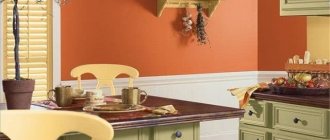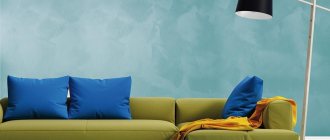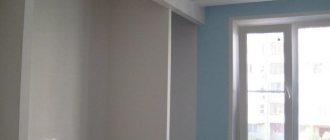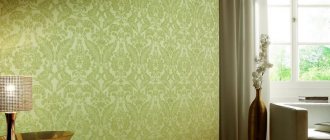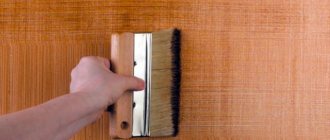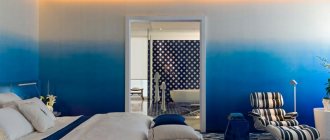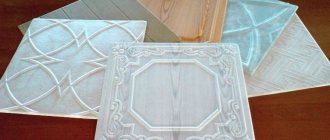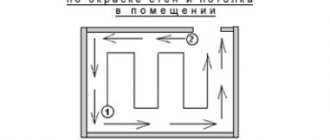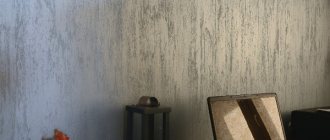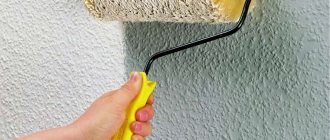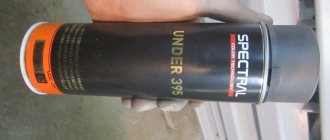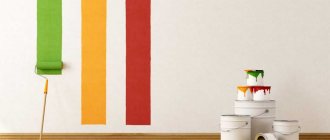Modern trends in interior design have again returned to the leading position the painting of walls with various types of paints. This is due, first of all, to the growing popularity of paintable wallpaper. In this vein, this type of wall decoration such as painting has begun to regain its position - it is beautiful, stylish, fits into any interior design style and, at the same time, is not too expensive.
Just a few decades ago, oil paint was used to decorate walls, since manufacturers of paint and varnish products did not offer an alternative. Everything changed with the advent of a line of water-based paints, as a result of which they no longer have equivalent replacements.
For information: water-based paint is a mixture (dispersion) of water with coloring pigments and tiny insoluble particles of polymers that are suspended. After the solvent (water) dries, a thin but very durable polymer film remains on the painted surface, which gives the painted materials an attractive appearance.
In such a kitchen, the appetite grows not only from the aromas of the food, but also from the beautiful interior.
The current situation was the result of many positive qualities of water-based compositions.
Advantages and disadvantages of water-based paint
Water-based paint has both strengths and weaknesses. The advantages include:
- the absence of a sharp unpleasant odor, which is imparted to other types of paint by a solvent, for example, acetone or white spirit;
- rapid dissipation of the damp smell that appears immediately after painting;
- environmentally friendly paint components - absolutely harmless to humans and the environment;
- Possibility of application to all types of wall materials;
- a fairly simple paint application technology, which makes it possible to paint walls with water-based paint yourself;
- Manufacturability: simply diluted, stirred, tinted and applied;
- variability of tinting with pigments - the paint can be given any color and shade;
- the ability to be easily washed off from tools, hands, clothing and the floor at the end of work;
- accessibility to the bulk of the population at a price;
- fast drying process;
- ability to fit into any interior and style;
- resistance to aggressive chemicals, primarily alkalis;
- vapor permeability allows the walls to breathe.
The disadvantages include:
- inability to withstand sub-zero temperatures - it cracks, and therefore cannot be used in unheated rooms (dachas, country houses, where visits are irregular in winter);
- significant labor costs in preparing walls for painting;
- susceptibility to colonization by fungus and mold, which multiply very actively in damp or poorly heated rooms.
Interesting design options
Walls painted with water-based paint can be the background for a modern design or create its uniqueness themselves.
Bold experimentation with colors in a teenager's room looks more like a piece of modernist art than a living space. Ideal order must reign here, otherwise the feeling of chaos will be oppressive. It is impossible to stay in such an interior for a long time when you get tired of the design - re-painting the walls with your own hands will not be difficult or expensive.
And this cute wall can be in the nursery or occupy part of the corridor. A simple design, created by yourself, brings a feeling of warmth, comfort and eternal summer. The drawing is applied with water-based paint in several layers, after the previous one has completely dried. Adjacent walls can be painted in lighter colors.
Painting with bright contrasting stripes is suitable for a spacious room of a dynamic owner. Not everyone can stand this combination of colors. Only a strong personality with clear goals in life will feel comfortable within the walls of such an interior.
Required materials and tools
Painting walls with water-based paint requires the purchase of the following materials:
- water-based paint (you need to buy one batch - different shades are possible in different containers);
- pigment dyes (if the paint is purchased white) to give the water-based emulsion the desired color and shade;
- primers for painting (Knauf, Ceresit and others).
In addition to materials, you will need the following tools:
- ladder;
- screwdriver (electric drill) with a mixer for stirring paint;
- a set of paint rollers (for paint and primer);
- spray gun or paint brush (5-8 cm) for painting corners and places near the baseboard;
- small brush for color correction in hard-to-reach places;
- crepe (painting) tape;
- cuvette for primer and paint;
- plastic film to protect furniture and floors from paint splashes or cardboard (old newspapers);
- construction tape for fastening polyethylene.
Which paint to choose
The quality of the repair depends on many factors, but the determining factor has always been the choice of finishing material, which is carried out according to specific criteria. In relation to water emulsion it is:
- paint color;
- degree of gloss;
- hygroscopicity;
- possibility of care.
Color
Water emulsion can have up to 200 colors and shades. It is unrealistic to produce paint with such color variety. Therefore, manufacturers took a more convenient path: they made white the base color, and at the same time launched tinting dyes for sale.
By mixing colors with white paint in various proportions, you can get complex colors that are not found on sale. In addition, by changing the proportions of various pigments, you can achieve different color intensities, moving from a rich tone to a restrained one, which in the language of designers is called the gradation effect.
This is what the color spectrum of water-based paint looks like.
You can mix paint with pigments at the seller (all major retailers provide this service) or at home. Tinting a house allows you to see how the walls will look after painting, since the color of the diluted paint does not match the color of the dried water-based emulsion.
Here a little trick comes to the rescue: the diluted paint is applied to the wall in a small area. After 2-3 hours you can see how the painted surface will look. If necessary, you can adjust the color by adding dyes to the paint container. Below is a tip on how to get some colors using several tints.
By mixing different pigments, you can get up to 200 colors and shades.
Gloss level
The appearance of the surface and the visual perception of the room depend not only on the chosen color and shade, but also on the degree of gloss. He can be:
- deeply matte - it looks impressive and respectable, but even a one-time cleaning with a damp cloth can disrupt the texture at the micro level (in plain language - you can’t rub, as shiny spots may appear);
- matte (the room visually increases in size, but on such a surface the slightest staining defects are clearly visible, it is difficult to wash with a damp cloth or napkin);
- semi-matte - maximum hides mistakes in preparing the wall for painting, is resistant to abrasion (washes well);
- glossy (emphasizes flaws, but maintenance is not a problem);
- semi-gloss - washes well.
The best option is to buy semi-matte or semi-gloss paint.
Hygroscopicity
There are always rooms in the apartment with different humidity levels:
- dry (children's room, bedroom, living room);
- with high humidity (hallway);
- with a high level of humidity (bathroom, toilet, kitchen).
For rooms with excess moisture in the air, moisture-resistant types of paints are produced. This point should be taken into account when purchasing a water-based emulsion.
Ease of care
Produced water-based paints can be:
- unsuitable for wet cleaning (clean only with a vacuum cleaner or dry cloth);
- washable (can be cleaned with a wet cloth or sponge using detergents);
- indelible - wash only with clean water.
Affects the final finishing result and the type of water-based paint. She may be:
Mineral. Mineral water-based paint is a budget type of paint, since it is based on cheap cement or lime. Applies well to concrete, brick, plasterboard, wood. However, the short service life (fades out quickly), high hygroscopicity and the impossibility of wet care have led to a drop in sales.
Acrylic. This is the most popular water-based paint. It has a long service life, low consumption per 1 m2 of wall, the ability to heal microcracks up to 1 mm wide, and easy maintenance. And most importantly - the most optimal combination of price and quality.
Semi-matte acrylic water-based emulsion, when applied in several layers, at least 3, perfectly hides minor surface defects due to the presence of acrylic resins, which do not allow the polymer film to deform, repeating all the irregularities on the wall. In addition, painted walls can withstand temperature changes and significant mechanical impacts, preventing the paint layer from breaking.
Disadvantages include low vapor permeability, which negatively affects the quality of paint when finishing poorly dried surfaces.
Silicate. Due to the introduction of potassium liquid glass into the composition, silicate paint forms a thin glass film on the wall after drying. This paint has a number of advantages:
- does not fade until the end of operation;
- serves for a long time - more than 20 years;
- resistant to temperature changes;
- does not burn;
- easy to clean;
- excellent resistance to fungus and mold;
- has a low price.
However, the disadvantages still outweigh:
- poorly tinted;
- there is no plasticity, and therefore all microcracks and other defects are not hidden, but, on the contrary, are emphasized;
- does not withstand high humidity well (you can only paint the living room and bedroom);
- does not adhere to porous and loose materials, as well as wooden walls.
As a result, the editors of the site advise you to refrain from purchasing silicate paints.
Silicone. The latest achievement of manufacturers of paint and varnish products is silicone water-soluble dye. It has no disadvantages, only advantages:
- good vapor permeability while being waterproof;
- high elasticity, which allows the paint layer to heal microcracks;
- resistance to mechanical stress;
- long service life;
- high aesthetic characteristics, etc.
Naturally, high quality corresponds to a high price.
For reference: many experts classify polyvinyl acetate paint materials as water-based paint. They are based on PVA glue, to which plasticizers and dyes are added. In our opinion, this type of paint does not fit into the classical understanding of water-based emulsion, and therefore is not considered in this material.
For clarity, we summarize the main parameters of water-based paints in a table.
| Properties\Types of paints | Mineral | Acrylic | Silicate | Silicone |
| Vapor permeability | low | high | average | high |
| Film strength | high | good | good | good |
| Color fastness | average | good | high | good |
| Fire resistance | No | average | high | average |
| Elasticity | average | high | No | good |
| Resistance to washing off | high | average | high | low |
| Mold resistance | average | low | high | average |
| Color palette | high | good | average | high |
| Hygroscopicity | high | low | No | average |
| Price | low | average | low | high |
These tables confirm preliminary conclusions: silicone dyes are the most effective. But in terms of price/quality ratio, acrylic paints are the leaders.
Calculation of the required amount of paint
When carrying out repair work, it is always unpleasant when the purchased material is not enough. This problem is most acute when purchasing water-based emulsion. After all, after an additional purchase, it is almost impossible to achieve the same shade if the paint is tinted yourself. Therefore, the question of how to calculate the amount of paint for walls needs to be given special attention. The whole process can be divided into III stages.
Stage I. The area of the surface to be painted is determined. To do this, measure the perimeter of the walls and then the height of the ceiling. When multiplying the resulting numbers, the total area of the walls is obtained. Windows and doors are measured. Their area is subtracted from the previously obtained result.
This is approximately how the wall area is calculated.
Stage II. The preliminary amount of paint is determined. To do this, the area to be painted is multiplied by the paint consumption per 1 m2 (always indicated on the packaging), the average value is given in the table and by the number of layers (minimum two).
Table 2. Average consumption of water-based paint per 1 m2.
| Water-based paint | 1 layer, g/m2 | 2 layer, g/m2 |
| Mineral | 340-370 | 200 |
| Acrylic | 250 | 150 |
| Silicate | 400 | 350 |
| Silicone | 300 | 150 |
Stage III. The obtained result is corrected. Let us immediately clarify that the packaging shows the paint consumption for a perfectly smooth surface, which has been primed in advance. Coloring:
- unprimed plastered surface increases consumption up to 10%;
- drywall without putty and primer by 40%;
- wallpaper for painting by 40-45%;
- trellises for painting with a relief surface of up to 70%.
The walls are painted not only with putty, but also with wallpaper for painting.
It also matters what tool you use to apply the paint. When using a roller and spray gun, no further adjustments are made. A paint brush requires an increase in the amount of water-based emulsion by about 5%.
You can save on painting materials by:
- a perfectly flat surface that can be obtained during the preparatory work;
- applying primer to the walls;
- Observe the order of painting: first, paint the corners with a brush, then the wall near the trim and baseboard (it’s still better to remove them). Only after this the rest of the surface is painted with a roller or spray gun. If the order is reversed, 1-2% of the water-based emulsion is lost.
Colorant – which composition to choose?
Today you can easily find any dye on an organic and inorganic basis. The first option allows you to get rich shades, which, unfortunately, over time lose their properties, fade and fade. Inorganic additives are more resistant to atmospheric and other influences, but their palette is significantly narrower compared to natural materials. The product range is presented on the market with universal colorants and compositions intended for specific types of paints.
To obtain the required color, the amount of color varies depending on the type of paint and varnish material. So, for oil paints the maximum amount of colorant should not exceed 1.5–2% of the total volume; in water-soluble paints and varnishes its amount can reach 20%, and for all others a maximum of 5% is added.
It is necessary to distinguish between the concepts of tinting and glazing. In the first case, color is added to white paint to achieve the desired shade. The second term refers to mixing two different colors to obtain a third (yellow + red = orange).
The amount of colorant to obtain the desired color depends on the type of paint and varnish material.
Manufacturers offer colorants in powder, liquid and paste form. For independent use, liquid dyes produced in small volumes in syringes or bottles are better suited. They are simple and easy to use. With their help, you can easily change the shade of paint by adding more dye for a rich color. In addition, it is allowed to use liquid color for painting in undiluted form as a coloring material.
But for mixing on professional equipment, powders and pastes are better suited. Dry dyes are inexpensive, but with their help it is difficult to achieve the desired shade, and they have a small selection of colors. As a rule, before adding the powder, it is diluted in a liquid that corresponds to the composition of the paints (linseed oil, water). Paste-like materials require precise proportions from the master, otherwise the color may turn out to be significantly lighter or darker than the desired result.
The best way to apply water-based emulsion
Painting technology allows the use of 3 types of painting tools:
- brushes;
- roller;
- spray gun.
It takes a long time to paint with a brush, which increases paint consumption. Buying or renting a spray gun is expensive for the family budget. Therefore, there is only one thing left to do: pick up a roller and paint the walls. However, difficulties arise here: which roller is best to paint walls with water-based paint? After all, there are dozens of types and varieties of paint rollers on store shelves.
Which roller is better to choose and how
Rollers are made from several types of materials:
Foam rubber. This is the simplest and cheapest type of paint roller. The low density of the material allows it to absorb a large amount of dye, which, on the one hand, is convenient - there is no need to frequently dip the tool in paint. On the other hand, a large amount of paint on the roller leads to the formation of many microscopic bubbles on the painted surface.
Velor. Among specialists, there is an ambiguous attitude towards such a tool, so it can only be found on sale in specialized retail outlets. The peculiarity is that the dense structure of the velor does not cause splashes and applies the paint evenly. But this coin also has a downside: you have to constantly dip the roller into paint, which for specialists means loss of income.
Fur. Available in natural and faux fur. When purchasing, you can not pay attention to the type of material, since there is practically no difference between them. But you need to look at the length of the pile. Short fibers splash heavily (i.e. abundantly and far) with paint. Long pile tends to come out of the base and also splashes, but not so abundantly. Therefore, the most acceptable option is a fur roller with medium-length pile.
Some subtleties of choosing an emulsion
- When buying white paint, it is better to choose one that contains titanium dioxide as a color. This compound gives a pure and even white color without other shades.
- To produce the material, ingredients imported from Europe are used, so the cost of good paint cannot be very low. You should not buy a suspiciously cheap emulsion; most likely, it will be counterfeit.
- If the VD paint code is marked with the number 1, then it is not suitable for painting the ceiling, since it is intended for the external walls of buildings. For internal surfaces use paint marked VD2.
Paint consumption is calculated based on the characteristics specified by the manufacturer on the label. Average consumption rates are in the range of 150-250 g/m². But if you need to tint the paint, then the solution needs to be prepared in slightly larger quantities. After all, if there is not enough of it, it will be quite difficult to get exactly the same shade.
Paint consumption also depends on the characteristics of the original surface, its smoothness and absorbency. By the way, cheap water-based paint, as a rule, is consumed more, so such an attempt to save money can cause even greater waste.
When buying paint, you need to carefully study all its characteristics so that the choice is informed and competent.
Important! If the paint is stored incorrectly, for example, in the cold, its structure will be damaged and its consumer characteristics will be lost. Therefore, it is important that the seller has an insulated warehouse for storing it.
Comparative characteristics of popular brands of water-based paint
Preparatory work
In the instructions on how to properly paint walls with water-based paint, special attention is paid to preparatory work. The final result largely depends on their quality. During their execution it is necessary:
- empty the room of furniture, cover the floors with film or newspapers;
- remove old finish;
Even with a strong desire, you cannot paint such a wall.
- inspect the walls. If necessary, remove old plaster, seal cracks and crevices;
- treat the walls with primer;
- level the surface using drywall or cement (gypsum) plaster;
- apply a primer under the putty;
- putty the walls using a technology that involves applying the last layer of finishing (fine) putty. If finishing putty was not purchased, and the walls were sanded using the starting composition of the putty solution, it is advisable to prime the surface.
It's a pleasure to work on putty walls.
Attention: the detailed process of preparing walls for painting can be seen in the work “Aligning walls for painting.”
How and what to prime
It is not at all necessary to prime the walls for water-based paint. Apart from increased consumption of materials, no other serious consequences are observed. This, by the way, is what apartment owners do in most cases when carrying out renovations. However, the high price of paint, especially silicone, forces the walls to be primed - the technological operation is justified by financial savings.
We should not forget that the primer allows:
- improve adhesion between the wall and the paintwork;
- strengthen the surface to be painted;
- protect walls from fungus and mold.
Of the variety of primers, it is best to use the acrylic primer of the famous brands Knauf or Ceresit. Russian primers are not much worse: “Prospectors”, “Tex” and others (price per 1 liter - 30-100 rubles).
The primer is applied with a brush in one pass, with a roller in two.
Priming the walls makes the job easier and saves paint.
It is equally effective to use homemade soil for walls. To do this, the paint is diluted with water in a ratio of 1:2, where 1 part is paint, 2 parts water. This composition, when painted in two layers, significantly improves the quality of painting.
How to paint walls: description of the work at all stages
Stage one. Wall surfaces have varying degrees of absorbency. Typically, water-based paint is applied in 2-3 layers. Careful priming will help reduce the absorption capacity of the surface. How this is done was described above.
Stage two. The prepared paint is poured into a clean tray. You need a container from which it would be convenient to take portions of the dye with both a roller and a brush. This paint bath has a ribbed surface for a reason: excess paint is easily wrung out, saving material.
Stage three. Dip the roller into the paint; you need to roll it in this mixture so that the “coat” of the roller can be evenly saturated. The first test stroke is made on the cardboard. And if the roller is well saturated, install a handle and begin to paint the wall.
For your information. Painting the wall starts from the top. Paint smudges will appear on the wall. This is not scary, since in the process of working from top to bottom, the smeared areas will still be evenly painted over - compared, rolled out with a roller.
The main area will be painted with a roller. Hard-to-reach places, especially corners, will need to be painted with a brush.
Stage four. The wall is painted in 2-3 layers. You need to wait each time for the previous layer to dry. Then it is possible to obtain a uniform coating.
It needs to be taken into account. There should be no drafts in the room. Strong air currents spoil the evenness of the paint, as individual areas in such areas dry unevenly.
Stage five. The wall is already painted and dry. Then, using an attachment, designs are applied to a roller or stencil, and paint of a different color is used. In this way it is possible to enliven a monotonous panorama of the wall.
It is also possible to create visual texture in another way. Using a sponge, paint of a different tone is applied to the dried surface. But first, the sponge is compressed with plastic wrap. You can use another homemade device.
Anyone can paint a carefully prepared, flat surface. The main thing is to carefully level the walls, because such a process is considered quite labor-intensive. And then any decision is a creative impulse.
Video: Spray gun for painting with water-based paint:
Painting instructions
How to paint walls with water-based paint? There is nothing difficult to understand or implement. Even a beginner can do the job. You just need to follow the rules:
- Painting is carried out using a completely dry primer or putty.
- The second and subsequent layers of paint are applied to completely dry previous layers (from 2 to 12 hours).
- Under sunlight, wet paint changes color. Therefore, work must be carried out either in the evening or with the windows covered with plastic film.
- Drafts contribute to the appearance of stains due to uneven drying of the applied paint. The same situation is observed when walls are forced to be heated with a heat gun or electric heating devices.
- A coat of paint should be applied to one wall within 15-20 minutes, which eliminates breaks and smoke breaks.
- According to technology, each layer of paint requires a new roller. In practice, they do it a little differently: thoroughly wash the used roller and then dry it. In terms of the quality of paint application, a previously used roller is not inferior to a new one.
- When changing the consistency of paint or tinting it, special attention must be paid to the periphery. It is on the sides of the container that poorly mixed paint is most often found, which is especially unacceptable when coloring pigments are introduced into its composition.
- The corners and narrow sections of the wall adjacent to the ceiling and floor are always painted first with a brush.
- If the trims and baseboards cannot be dismantled, they must be sealed with masking tape.
- For the first layer, the paint is diluted a little more.
DIY wall painting
Well, you already know how to choose paint or prepare the wall, all that’s left is the paint itself. It needs to start... yes, yes, all from the same revision! During the time you were running, buying paint, carrying something, waiting, moving, the walls could have been scratched ten times, or hit somewhere. Believe me, it’s much easier to skim the surface at this stage than to fix new problems later.
After the inspection, films and masking tape are applied. Everything that can get dirty, such as the floor, ceiling and stucco, must be carefully sealed. Yes, the process of wrapping a room cannot be called fun and fast, but removing paint from already finished surfaces is an even sadder procedure.
After pasting comes priming. And don’t look at the fact that you have already done this process with the wall more than once. It doesn't matter, it's already covered five times with dust, which will definitely interfere with normal adhesion.
Then, or rather about two hours later, after the primer has dried, you can start painting. As for the tools, you will need a bath, a couple of rollers and several brushes for those places where you just can’t get to it.
When the tool is ready to use, pour some paint into the tray and get started. You should start from the perimeter. Carefully go around it with a roller one and a half its width, especially carefully rolling out the end strip of the mark. There shouldn’t be a clear boundary between where the paint has already applied and where it hasn’t, otherwise you won’t be able to get it anywhere.
When you're done, grab the main plane. Wet the roller with paint and, starting from the window (never vice versa.), roll up the surface without any pressure.
And another small nuance: after the next wetting, you don’t need to start in the same place where the roller stopped a minute ago. Step back from the painted strip at least 10-15 centimeters and gradually roll up the resulting island. With this approach, the paint will lie more evenly.
Yes, we almost completely forgot (so many nuances). Painting walls is an exclusively daytime activity that should be done exclusively in natural light! At night, even with the best illumination, it is impossible to paint the walls efficiently.
Preparing the Paint
When opening a container of paint, its consistency is almost always much thicker than required for the job. Therefore, the paint is thoroughly mixed, adding water in small portions so as not to dilute more than necessary.
This operation is most conveniently performed with a screwdriver with a mixer attachment. If you don’t have a power tool, you can stir with any object, but it takes a long time and the quality is a little worse.
The easiest and fastest way to stir paint is to use a screwdriver with a mixing attachment.
If the wall design is creative and involves the surface shimmering under streams of light, it is at this moment that various sparkles are added to the paint. But such ideas come to owners quite rarely.
If small grains appear on the surface of the paint in the funnel, the water-based emulsion must be filtered through 3 layers of gauze.
Paint tinting
Giving paint a certain color and tone at home is carried out according to the following algorithm:
- The water emulsion is poured into a large container (usually a 10 liter bucket) so that it is enough to paint the walls in one room, since it is almost impossible to obtain the same color and shade again. As an exception, for a wall with a window you can make the paint a little lighter, as a result of which the room will visually appear larger;
- adding water in small portions, the paint is brought to the required consistency while mixing;
- Tinting pigments are added to the water-based composition, after which the paint is thoroughly mixed. If necessary, the resulting color is adjusted: new pigments are added or the number of those already added is increased. Everything gets mixed up again;
To see the final result you need to paint a small section of the wall.
- With the resulting paint, a small section of the wall is painted so that after about 2 hours you can see the real color scheme of the interior. If the result is not satisfactory, the tinting process continues.
What do you need to know about water emulsion?
Attention:
Water emulsion contains water, tinting pigments, and various additives - mineral particles or polymers. During dyeing, the water component dries out, leaving behind a thin film.
This composition does not have an unpleasant chemical odor, which is a huge “plus”: people with allergies to such building material can use it without fear of having another attack. And it will be more comfortable for healthy people to paint walls in a room where it is impossible to open the windows.
Please rate when purchasing:
- Composition (depending on the amount of antiseptic, thickener, fillers, it may or may not be suitable for interior work, for dry or wet rooms).
- What kind of walls are needed : concrete, enamel, wood or something else.
- Viscosity level (what, how it needs to be diluted).
- Consumption (average consumption per square meter - 200-400 ml).
- Temperature during application and drying.
- Permissible humidity level during operation, during operation.
- Specific gravity (a high-quality water emulsion in a 10-liter jar will weigh approximately 15 kg).
The jar should be stored in a dry place where sunlight does not penetrate.
Painting technique
You can paint walls with a brush, roller or spray gun. There are technologies developed over the years for this.
Painting with a brush
For those nostalgic for the good old days, we recommend painting the walls with a brush. But we warn you right away. This takes a long time, is not of very good quality, and the paint consumption is a little higher (some will end up on the floor in the form of drops, some will remain on the wall in a thicker layer of paint).
Before starting work, the brushes (a large flywheel and a small corrective one will be required) are soaked in water so that no bristles remain on the wall during the work.
The paint is poured into a cuvette if the packaging is large, or remains in the jar. In the latter case, the water emulsion is stirred regularly, approximately every half hour, to maintain a homogeneous composition.
The brush is dipped about 1/3 of the way, after which excess paint is removed with light blows against the wall of the jar or tray. The coloring starts from the upper left corner and goes down in narrow stripes. The coloring composition is applied in a thin, uniform layer. The brush is held almost perpendicular to the wall, the pressure is light.
The application technique may vary, but experts advise first applying a vertical stroke, and then blending it with zigzag movements. This way you can ensure that the wall is free of smudges and streaks.
The second technique involves applying one layer with vertical movements, the second with horizontal movements, without shading. With this application, omissions are eliminated, but the likelihood of smudges and streaks increases.
Roller
Painting the walls with a roller is carried out in the following sequence:
- paint is poured into the tray;
- the roller is wetted around its entire circumference. To do this, it is dipped into the paint and then rolled along the ribbed surface of the cuvette. And so on several times until the fur is saturated with the water-based composition. If you skip this work, there will be “unpainted” marks on the wall that are not visible when wet;
- wet the roller again and, rolling it along the edges of the ditch, distribute the paint evenly over the entire circumference;
Use a roller to paint in a W-shaped motion.
- you need to start painting from a corner, any corner. Lead from top to bottom according to a pattern reminiscent of the Latin letter “W”. The color stripe is about half a meter. The stripes are applied with an overlap of 5-10 cm;
- paint drips are removed with a used (dry) roller - the pile will absorb the drips. In this case, the movements of the roller should also be similar to the letter “W”.
How many times does a wall need to be painted with a roller? 2 layers are enough. The second layer of paint is applied to the dried first one.
Spray gun
Using a spray gun to paint walls not only gives excellent results, but also brings pleasure from the work - it is easy and pleasant. The technology consists of several steps.
- The paint is diluted (more than usual), mixed, and then filtered through cheesecloth (small particles can clog the nozzle).
- The supply of dye is regulated, for which an unnecessary object is dyed within a few seconds.
- After stabilizing the paint flow, the nozzle is brought perpendicular to the wall at a distance of 30-60 cm. The movement for the first layer is horizontal, for the second - vertical, at a speed of approximately 1 m per 5 seconds.
- Coloring starts from the top. Paint in sections. The next square is started after coloring the previous one. The pace should be even. Any delay leads to a thick layer of paint that begins to flow down. Therefore, it is better to underpaint than to overpaint - the next layer will hide the defect.
- Improved painting of walls with water-based compositions when using a spray gun is achieved by painting 3 times - three layers are applied.
Advantages of painting walls with water-based emulsion
The main advantages of this type of staining include:
- Drying speed. Painted walls are suitable for further work after 2-3 hours.
- No pungent odor.
- It does not contain harmful chemicals that can cause allergies.
- A very simple method of painting: you don’t need to use special solvents, your hands can be washed well after it.
- You can get any color yourself by mixing colors, or diluting them to a certain shade.
- Thanks to special additives, it is suitable for walls with high humidity levels: kitchens, bathrooms, toilets.
- The composition of the paint ensures good adhesion to the wall, which is why cracks and chips do not form for a long time.
- The water-based emulsion ensures that the surface is vapor-tight, so that fungus and microorganisms will not appear on the wall.
To give the paint the desired shade, add a special toner.
Decorative painting
Uneven painting of walls is becoming increasingly popular - their surface looks unusual, emphasizing the unconventional thinking of the owners. There are many techniques and design techniques for decorative painting. Some of them have already been discussed in the work “Wall finishing with decorative plaster”.
We will describe some below (the amount of work does not allow us to consider everything).
- A wall with a pattern is obtained by applying 3 layers of paint with a two-part roller, where one roller wets the second with a cut-out pattern in the paint. The technique is clearly visible in the photo below.
Drawing is very simple.
- Stencils with a pattern are cut out of a dense but thin material, onto which paint is applied. It is best to work on a stencil with a sponge or, in extreme cases, a used roller. Otherwise there will be streaks under the stencil.
- With a homemade roller you can get an unusual, chaotic pattern. You can understand how this works from the photo below.
Any material at hand can become a decorating tool.
A painted wall can be changed beyond recognition with the help of auxiliary tools.
- Another non-standard painting technique: spraying. The first layer of paint is applied to the wall. The second is applied with a brush, but not with strokes, but chaotically.
A more impressive effect can be achieved by using textured paint. Water-based compositions do not belong to this type of dye. But if you thicken the water-based emulsion (evaporate some of the water), then it behaves like textured paint, which makes it possible to have unusual walls.
So, if you add metal particles and reflective quartz sand (commercially available) to a light brown thickened water-based composition and then apply it unevenly, you will get a relief called “Atacama”.
This is what the Atacama texture looks like.
Where are water-dispersed compositions used?
The areas of application of such paints are practically unlimited. These can be various surfaces indoors and outdoors. We can say that water-based compositions are universal. They are often used for painting walls in children's rooms, preschool and educational organizations due to the absence of harmful substances in them.
For children, water-based paint will be the best solution PHOTO: stroyfora.ru
Tips for further care
Water-based emulsion has poor abrasion resistance. Therefore, it is necessary to clean and wash carefully. First, conspicuous stains are removed. They need to be wiped point by point, without greatly affecting the paint nearby. The movements must be circular, otherwise the top layer of paint can be erased. It is best to do this with melamine sponges, but only carefully, without strong friction.
Can't be cleaned often. For washable paints, you can use dishwashing liquid. If the water-based composition contains latex particles, you can wash it with soapy water - the dirt will be easily washed off.
Painting walls with water-based paint fits into any interior, complementing or emphasizing the chosen design style. The painting technique does not have points that are difficult to understand and perform, which allows you to do the apartment renovation work yourself.
Taking into account what parameters paints are chosen
Water-dispersion and water-based paints are recognized as the best options for decorating walls and ceiling surfaces in any office or residential space. It is necessary to pay attention to the many positive qualities of such compositions.
Firstly, there is no unpleasant odor in the treated area. So you can work even in rooms with closed windows.
Secondly, water emulsion is an absolutely environmentally friendly product. People and animals can safely stay in painted rooms.
Thirdly, this paint has high moisture permeability. Therefore, it is even suitable for decorating walls in rooms where humidity is high. The main thing is to properly prepare the wall or ceiling for painting.
Fourthly, the surface painted with a water-based composition takes on an even matte shade. This coating allows designers to successfully implement the most daring ideas; the basis for this has already been prepared.
Aqueous emulsions made using acrylic resins are in great demand. Then the dye gains strength and elasticity. The only disadvantage is the high price. But you can choose paint at an affordable price, but also with the inclusion of acrylic components. These are the compositions:
Matte latex paint
